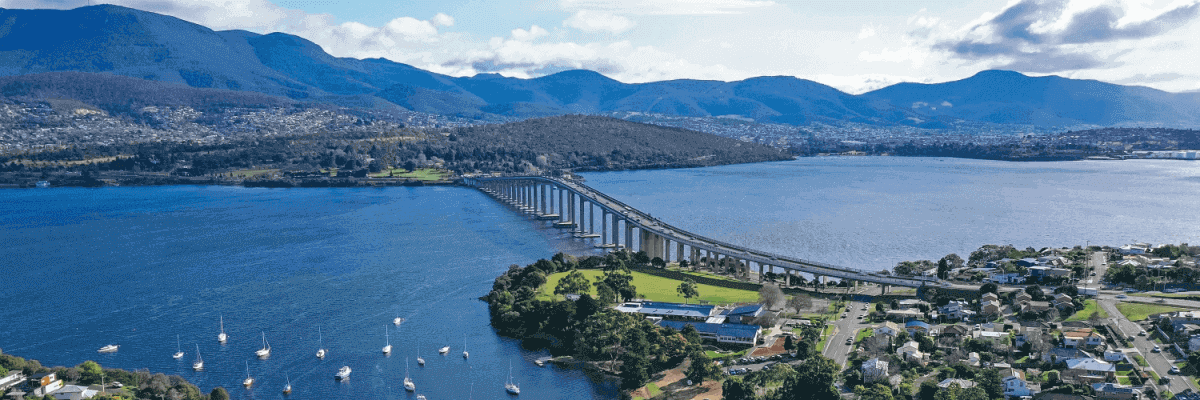KEY POINTS
- Energy Locals, CovaU Energy, 1st Energy, Solstice Energy and Aurora Energy all now offer energy in Tasmania.
- Tasmania’s electricity supply is managed by TasNetworks and its main energy generator is Hydro Tasmania.
- Aurora Energy was the only electricity retailer in Tasmania until 1st Energy joined in 2019.
On this page:
- What’s the difference between generators, distributors and providers in Tasmania?
- Electricity providers in Tasmania
- Tasmanian electricity prices explained
- Solar feed-in tariffs in Tasmania
- How to install solar in Tasmania
- Tasmanian gas prices explained
- What’s next for Tasmania’s energy industry?
- Tasmania energy FAQs
What’s the difference between generators, distributors and providers in Tasmania?
The electricity and gas markets can be split into three tiers – providers (or retailers), distributors and generators.
- Generators: Produce electricity and/or natural gas. Tasmania’s main electricity generator is Hydro Tasmania. Natural gas in Tasmania is imported from a variety of generators on the mainland.
- Distributors: These companies are responsible for delivering the electricity and gas from the generators to your property. Tasmania’s electricity distributor is TasNetworks, which is responsible for maintaining the poles and wires, and checking and maintaining electricity meters.
- There are two gas distributors in Tasmania – Aurora Gas and Solstice Energy.
- Providers/retailers: Are responsible for billing and customer services.
Electricity providers in Tasmania
The Tasmanian Government introduced Full Retail Competition in 2014, allowing for other retailers to enter the market and compete for customers.
Currently, customers can freely choose from five providers who are operating in Tasmania: Aurora Energy, CovaU Energy, 1st Energy, Energy Locals and Solstice Energy.
Aurora Energy rates
Aurora Energy is a state government-owned electricity retailer in Tasmania and until recently was Tasmania’s only electricity retailer. Aurora’s prices remain fairly reasonable despite the relative lack of discounting and competition.
The table below shows Aurora Energy’s electricity usage and supply charges:
CovaU Energy
CovaU Energy is an energy provider offering plans throughout Australia that also followed 1st Energy into Tasmania and now offers two variable electricity plans.
1st Energy rates
1st Energy was the first electricity provider to challenge Aurora Energy in Tasmania. 1st Energy offers very similar prices across its tariff structures. However, even subtle differences can have a big impact on price over time.
Here’s what energy plans are currently on offer from 1st Energy:
Energy Locals rates
Energy Locals customers will need to pay a monthly membership fee to unlock cheaper wholesale prices.
Here’s what’s on offer from Energy Locals:
Solstice Energy rates
Solstice Energy has been offering natural gas to customers since 2003, and in July 2024 expanded as an electricity provider in Tasmania. Solstice offers seriously competitive prices, including usage rates lower than the regulated price and a higher solar feed-in tariff.
Here’s what’s on offer from Solstice Energy, current as of August 2025:
← Mobile/tablet users, scroll sideways to view full table →
| Tariff | Tariff type | Supply charge per day | Usage charge per kWh |
|---|---|---|---|
| TAS31* | Anytime | $1.369397 | $0.284725 |
| TAS41* | Heating and hot water | $0.208712 | $0.194337 |
| TAS61* | Controlled load | $0.266179 | $0.147348 |
| TAS63 | Controlled load | $0.254434 | $0.140217 |
| TAS93 | Time of use | $1.481578 | Peak: $0.347686 |
| Off-peak: $0.163525 |
Prices as of August 2025. Visit Solstice Energy for more details.
* Tariffs are now obsolete and not available for new connections.
Tasmanian electricity rates explained
Despite retail competition in the state being deregulated, prices in Tasmania still remain regulated by the government. This means that there is very little room for variation in price for retailers in the state.
Tasmania’s energy pricing is made up of tariffs. A tariff refers to the electricity pricing structure. Different rates apply to the different tariffs. The table below explains the different tariff types customers in Tasmania can expect to see on their energy bill.
← Mobile/tablet users, scroll sideways to view full table →
| Tariff | What does this mean? |
|---|---|
| Tariff 31* | Tariff 31 is a flat rate tariff that makes up the energy charges for light and power. Tariff 31 is no longer available to new customers, though current customers can continue to use it. |
| Tariff 41* | Tariff 41 is a flat rate tariff that covers the energy charges for heating your home and water, but also air conditioners and indoor pools. Tariff 41 is no longer available to new customers, though current customers can continue to use it. |
| Tariff 93 | Tariff 93 is a time of use tariff available to households with smart meters. With this tariff, Tasmanians are charged different rates for power, whether it’s used at peak or off-peak times. Peak times apply between 7am & 10am and 4pm & 9pm Monday-Friday. Off-peak rates apply at all other times. Tariff 93 is used in place of Tariff 31. |
| Tariff 61* | Tariff 61 is a controlled load off-peak tariff with an afternoon boost and is used for home heaters, hot water systems, underfloor heating and pool heating. Tariff 61 is no longer available to new customers, though current customers can continue to use it. This tariff type does not operate as a primary electricity tariff. |
| Tariff 62 | Tariff 62 is the night-time only controlled load tariff for high consumption appliances for home and water heating. This tariff type does not operate as a primary electricity tariff. |
* Tariffs are now obsolete and not available for new connections.
Solar feed-in tariffs in Tasmania
A feed-in tariff (FiT) is a small credit rebate that households receive for any excess electricity produced by a solar system (or other small-scale generator) that is exported to the electricity grid.
As of July 2025, the minimum solar FiT rate was set to 8.782c/kWh in Tasmania. However, some providers choose to offer more competitive rates than this.
Here are the solar FiTs on offer from Tasmania’s energy retailers as of August 2025:
- Aurora Energy: 8.78c/kWh – 8.94c/kWh
- 1st Energy: 8.78c/kWh
- CovaU Energy: 8.88c/kWh – 8.94c/kWh
- Energy Locals: 8.78c/kWh
- Solstice Energy: 10c/kWh
Please check the websites of electricity providers in Tasmania for more details.
How to install solar in Tasmania
There are six steps to installing solar in Tasmania:
- The customer finds an accredited solar installer.
- The solar installer submits a connection application with TasNetworks.
- TasNetworks assesses whether the solar system meets technical requirements and whether the network can accommodate the solar system.
- Once approved, the solar installer will begin installation.
- Before switching the solar system on, TasNetworks will install a digital import-export meter which makes it possible to receive a FiT.
- The solar system is switched on and you’re ready to start saving with the power of the sun.
If you want to learn more about solar and how to find a reliable installer, check out the Canstar Blue solar buying guide.
Advertisement
Tasmanian gas prices explained
Following the introduction of Full Retail Competition, Tasmanians can choose from two natural gas retailers in Tasmania, Solstice Energy and Aurora Energy.
Both retailers supply gas to the full range of customers, including residential, business and industrial, yet there is a negligible difference in price between them.
There are also no published discounts and very little consumer switching, so your choice of gas supplier will ultimately come down to the quality of service and personal preference.
As shown below, Solstice usage rates are cheaper. However, the retailer’s supply charges are slightly higher.
Aurora Energy gas rates
← Mobile/tablet users, scroll sideways to view full table →
| Customer type | Daily supply charge | Usage charge |
|---|---|---|
| Residential | 77.37¢/day | 5.7285c/MJ |
Prices as of August 2025. Visit Aurora Energy for more details
Solstice Energy gas rates
← Mobile/tablet users, scroll sideways to view full table →
| Customer type | Daily supply charge | Usage charge |
|---|---|---|
| Residential | 77.40¢/day | 5.193¢/MJ |
Prices as of August 2025. Visit Solstice Energy for more details
What’s next for Tasmania’s energy industry?
Tasmania is currently too small of a market for most major electricity providers to invest in.
While electricity prices are regulated, it’s doubtful that mainland retailers will see much opportunity in joining Tasmania’s energy market.
While Tasmanians are restricted in retailer choice, there are other ways to save on energy. You can begin by comparing electricity providers via the Canstar Blue button below.
Tasmania energy FAQs
The following electricity providers in Tasmania offer electricity plans to small businesses:
- 1st Energy
- Aurora Energy
- CovaU Energy
- Energy Locals
- Flow Power
- Solstice Energy.
According to the Australian Energy Retailer (AER), businesses using less than 150mWh are charged the same as residential Aurora customers, while a different pricing structure applies to businesses using more than 150mWh.
Here are the choices available for large Tasmanian businesses with higher electricity consumption needs:
- Shell Energy, for businesses that spend over $30,000 on electricity
- Flow Power (access to wholesale energy).
Note: We do our best to keep the details on this page up to date as new information becomes available. However, please check directly with plan discounts and their availability through Canstar Blue’s energy comparison hub.
Tasmania’s retailers have other ways to help reduce your overall costs – namely through conditional discounts.
Electricity retailers in Tasmania currently offer the following electricity discounts:
- 1st Energy
- RACT Saver plan: Customers on the RACT Saver plan will receive a $150 discount – $75 once the customer has remained with 1st Energy for six months and another $75 at 12 months. Available for RACT customers only.
1st Plus plan: Customers on the 1st Plus plan will receive a $100 discount – $50 at six months and another $50 at 12 months.
- RACT Saver plan: Customers on the RACT Saver plan will receive a $150 discount – $75 once the customer has remained with 1st Energy for six months and another $75 at 12 months. Available for RACT customers only.
- Aurora Energy
- Customers who pay by direct debit may be eligible to receive a $20 direct debit discount.
- CovaU Energy
- CovaU Energy’s Freedom plan offers customers a guaranteed discount on total usage, and a $50 refer-a-friend offer for both referrer and referee.
- Energy Locals
- All market offers have a $50 refer-a-friend credit for both referrer and referee.
If you’re having trouble with your electricity meter, experience a power outage, want to report a faulty streetlight, or you need clearance to work near power cables, you should contact TasNetworks.
TasNetworks is available to contact 9am-5pm Monday to Friday for general enquiries.
The emergency line operates 24 hours, seven days a week.
- Emergencies and faults: 132 004
- General enquiries: 1300 137 008
- Customer feedback: 1800 060 399
Note: We do our best to keep the details on this page up to date as new information becomes available. However, please check directly with the Tasmanian Government’s Concessions and Rebates page.
The Annual Electricity Concession offers eligible households a daily concession of 176.866c to help customers pay energy bills.
Another available rebate for Tasmanians is the Australian Government’s Energy Bill Relief Fund, which is two quarterly bill discounts of $75, up to a maximum $150. This is an automatic rebate that your energy provider will apply directly to your bill. Embedded network customers will need to apply for a grant payment via the Department of State Growth.
Other available concessions include the Heating Allowance (two $28 payments per year), Life Support (daily discounts for those on approved life support systems) and Medical Cooling and Heating Concessions (52.975c per day).




Share this article